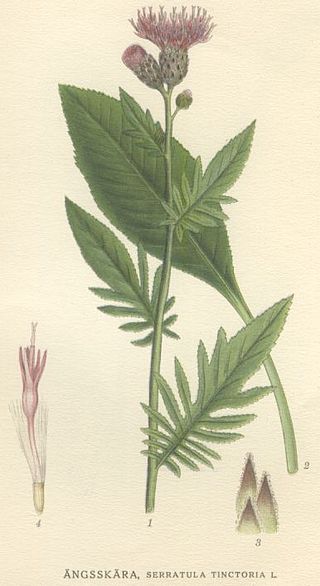
The Salsoloideae are a subfamily of the Amaranthaceae, formerly in family Chenopodiaceae.

The Cardueae are a tribe of flowering plants in the daisy family (Asteraceae) and the subfamily Carduoideae. Most of them are commonly known as thistles; four of the best known genera are Carduus, Cynara, Cirsium, and Onopordum.

Serratula is a genus of plants in the tribe Cardueae within the family Asteraceae native to Eurasia. Plumeless saw-wort is a common name for plants in this genus. Serratula as traditionally defined contains at least two groups: one of which is basal within the subtribe Centaureinae and one of which is derived; the former group can be moved to the genus Klasea.

Lagochilus is a genus of the mint family that contains Turkistan mint.
Carl Anton von Meyer was a German, Russified botanist and explorer.

Salsola is a genus of the subfamily Salsoloideae in the family Amaranthaceae. The genus sensu stricto is distributed in central and southwestern Asia, North Africa, and the Mediterranean. A common name of various members of this genus and related genera is saltwort, for their salt tolerance. The genus name Salsola is from the Latin salsus, meaning "salty".

Calligonum is a genus of plants in the family Polygonaceae with about 80 species across the Mediterranean Sea region, Asia and North America.

Corispermum is a genus of plants in the family Amaranthaceae. Common names given to members of the genus involve bugseed, tickseed, and tumbleweed. In general, these are erect annual plants with flat, thin leaves and topped with inflorescences of flowers with long bracts. Bugseeds are native to North America and Eurasia, but little is known about their taxonomy and distribution.

Jurinea is a genus of flowering plants in the family Asteraceae.
Russowia is a genus of Asian flowering plants in the tribe Cardueae within the family Asteraceae. The only known species is Russowia sogdiana, native to Kazakhstan, Kyrgyzstan, Xinjiang, Tajikistan, Uzbekistan, Afghanistan and Turkmenistan.
Calligonum leucocladum is a species of flowering plant in the family Polygonaceae. It is native to Central Asia and to Xinjiang in China. In Uzbekistan, it is limited to the Sokh River basin where it is endangered with a population fragmented by habitat loss from cutting and grazing.

Anabasis is a genus of plants in the subfamily Salsoloideae of the family Amaranthaceae. It is distributed in southern Europe, North Africa, and Asia.

Heterochroa is a genus of flowering plants in the carnation family, Caryophyllaceae. It includes six species native to temperate Eurasia, ranging from Iran to Central Asia, Mongolia, Siberia, and the Russian Far East.
Iris halophila var. sogdiana is a species in the genus Iris, subgenus Limniris and series Spuriae. It is a variety of Iris halophila. It was once a species in its own right as Iris sogdiana, before being re-classified as a synonym of Iris halophila, but it has been re-classed again as a variant of Iris halophila. It is a rhizomatous perennial plant, with blue-violet flowers. It is cultivated as an ornamental plant in temperate regions.

Phlomoides, also called Jerusalem sage and Lampwick plant, is a genus of over 130 species of flowering plants in the family Lamiaceae, native from the eastern Mediterranean Basin through Eastern Europe, western and central Asia, and the Indian subcontinent to China, Korea, and the Russian Far East. Phlomoides now comprises many species formerly in the genus Phlomis, and the former genera Eremostachys, Lamiophlomis, Notochaete, and Pseuderemostachys.

Fraxinus sogdiana, known as the Tianshan ash, is a species of flowering plant belonging to the family Oleaceae.
Arthrophytum is a genus of flowering plants belonging to the family Amaranthaceae.
Halocharis is a genus of flowering plants belonging to the family Amaranthaceae.

Petrosimonia is a genus of flowering plants belonging to the family Amaranthaceae. It is also in the Salsoloideae tribe.
Hyalolaena is a genus of flowering plants belonging to the family Apiaceae.











